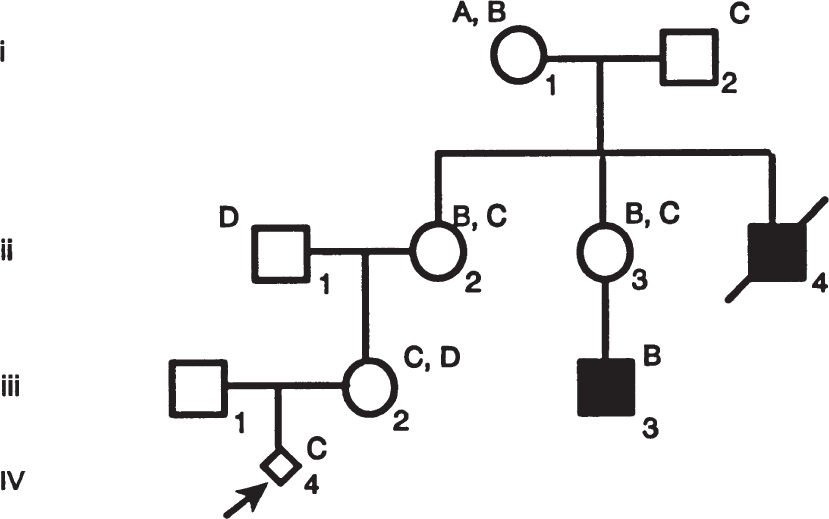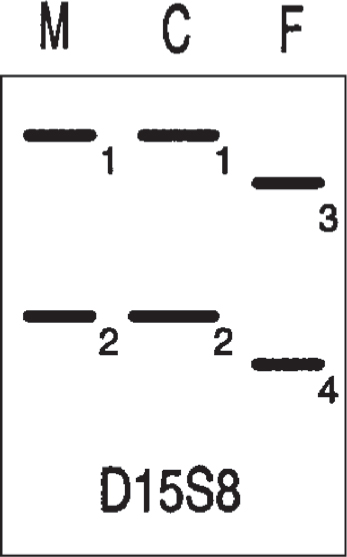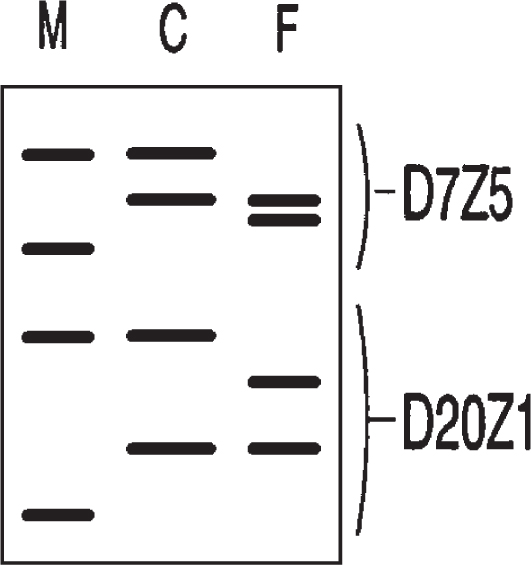a. Steps A and B
b. Steps A, B, and C
c. Step D alone
d. Step E alone
e. All steps (A-E)
277. A 2-day-old Caucasian boy becomes progressively lethargic after feeding and increases his respiratory rate. He becomes virtually comatose, responding only to painful stimuli, and exhibits mild respiratory alkalosis. Suspicion of a urea cycle disorder is aroused, and evaluation of serum amino acid levels is initiated. In the presence of hyperammonemia, production of which of the following amino acids is always increased?
a. Glycine
b. Arginine
c. Proline
d. Histidine
e. Glutamine
278. A 2-year-old African American girl has been healthy until the past weekend when she contracted a viral illness at day care with vomiting, diarrhea, and progressive lethargy. She presents to the office on Monday having been unable to eat and drink much over the weekend; she is lethargic with signs of dehydration including cracked lips, sunken eyes, lack of tears, and flaccid skin with “tenting” on pinching. She also has a weak pulse with low blood pressure and increased deep tendon reflexes. Laboratory tests show low blood glucose, normal electrolytes, elevated liver enzymes, and (on chest x-ray) a dilated heart. Urinalysis reveals no infection and no ketones. The child is hospitalized and stabilized with 10% glucose infusion, and certain admission laboratories come back 1 week later showing elevated medium-chain fatty acyl carnitines in blood and six to eight carbon dicarboxylic acids in the urine. The most likely disorder in this child involves which of the following?
a. Defect of medium-chain coenzyme A dehydrogenase
b. Defect of medium-chain fatty acyl synthetase
c. Mitochondrial defect in the electron transport chain
d. Glycogen storage disease
e. Urea cycle disorder
279. A 15-year-old Caucasian adolescent has a long history of school problems and is labeled as hyperactive. His tissues are puffy, giving his face a “coarse” appearance. His IQ tests have declined recently and are now markedly below normal. Laboratory studies demonstrate normal amounts of sphingolipids in fibroblast cultures with increased amounts of glycosaminoglycans in urine. Which of the following enzyme deficiencies might explain the intellectual deterioration?
a. Hexosaminidase A
b. Glucocerebrosidase
c. α-L-iduronidase
d. α-Galactocerebrosidase
e. β-Galactosidase
280. A 3-month-old African American boy presents with poor feeding and growth, low muscle tone (hypotonia), elevation of blood lactic acid (lactic acidemia), and mild acidosis (blood pH 7.3-7.35). The ratio of pyruvate to lactate in serum is elevated, and there is decreased conversion of pyruvate to acetyl coenzyme A in fibroblasts. Which of the following compounds should be considered for therapy?
a. Pyridoxine
b. Thiamine
c. Free fatty acids
d. Biotin
e. Ascorbic acid
281. Which of the following characteristics is most typical of multifactorial inheritance?
a. Sex predilection
b. Mitochondrial inheritance
c. Recurrence risks reflect the number of affected relatives
d. Major cause of miscarriages
e. Maternally derived
282. A physician evaluates a 16-year-old Caucasian adolescent with a slightly unusual facial appearance and poor school performance. A peripheral blood chromosome study reveals a karyotype of 46,XY/47,XY,+8 mosaicism, with 10% of 100 examined cells showing the extra chromosome 8. Which of the following options is most appropriate for the physician during the counseling session that follows the chromosome result?
a. Recommend karyotyping of the parents.
b. Explain that the recurrence risk for such chromosomal aberrations is about 1%.
c. Urge that the school receives a copy of the karyotype, since these boys often have behavior problems.
d. Recommend special education.
e. Inform the parents that their child will be sterile.
283. A 4-year-old Caucasian boy presents to the physician’s office with coarse facies, short stature, stiffening of the joints, and mental retardation. The physician performs a urine screen that shows elevated mucopolysaccharides and makes a tentative diagnosis of mucopolysaccharidosis. The boy’s parents, a 10-year-old sister, and an 8-year-old brother all appear unaffected but the mother had a brother who died at 15 years of age with similar findings that seemed to worsen with age. The mother also has a nephew (her sister’s son) who exhibits similar clinical findings. During the evaluation of her son, the mother reveals she is 5 months pregnant. Based on the probable mode of inheritance, which of the following is the risk that her fetus is affected?
a. 100%
b. 67%
c. 50%
d. 25%
e. Virtually 0
284. A couple comes to the physician’s office after having had two sons affected with a similar disease. The first-born son is tall and thin and has dislocated lenses and an IQ of 70. He has also experienced several episodes of deep vein thromboses. The chart mentions deficiency of the enzyme cystathionine-β-synthase, but a diagnosis is not given. The second son was treated from an early age with pyridoxine (vitamin B6) and is less severely affected. No other family members are affected. While taking a family history, the physician discovers that the parents are first cousins. The 38-year-old mother is pregnant, and amniocentesis has demonstrated that the fetus has a 46,XY karyotype. What is the risk that the fetus will be affected with the same disease?
a. 100%
b. 67%
c. 50%
d. 25%
e. Virtually 0
285. A 35-year-old African American male affected with Crouzon syndrome (MIM*123500) has craniosynostosis (ie, premature closure of the skull sutures) along with unusual facies that includes proptosis secondary to shallow orbits, hypoplasia of the maxilla, and a prominent nose. His son and brother are also affected, although two daughters and his wife are not. The patient and his wife are considering having another child. Their physician counsels them that their child might inherit Crouzon syndrome from his father. Which of the following risk percentages are most likely?
a. 100%
b. 67%
c. 50%
d. 25%
e. Virtually 0
286. Waardenburg syndrome (MIM*193500) is an autosomal dominant condition that accounts for 1.4% of cases of congenital deafness. In addition to deafness, patients with this condition have an atypical facial appearance, including lateral displacement of the inner canthi (eye corners), hypertelorism (widely spaced eyes), poliosis (white forelock), and white patches of skin on the ventral midline (partial albinism or piebaldism). A mother has Waardenburg syndrome, her husband is unaffected, and they plan to have a family with three children. What is the probability that only one of the three children will be affected?
a. 1/8
b. ¼
c. 3/8
d. 1/3
e. ½
287. Phenylketonuria (PKU—MIM*261600) is an autosomal recessive disease that causes severe mental retardation if it is undetected. Two normal parents are told by their state neonatal screening program that their third child has PKU. Assuming that the initial screening is accurate, what is the risk that their first child is a carrier for PKU?
a. 100%
b. 67%
c. 50%
d. 25%
e. Virtually 0
288. Individuals with Parkinson disease (PD-MIM*168601) have dopamine deficiency in the substantia nigra of the central nervous system. Which of the following would comprise the best strategy for therapy?
a. Feedback inhibition of dopamine oxidation
b. Competitive inhibition of biosynthesis from histidine
c. Provision of metabolites in the tyrosine pathway
d. Stimulation of monoamine oxidase
e. Provision of metabolites in the alanine pathway
289. A 3-year-old Caucasian girl is scheduled for a tonsillectomy. As she is prepared for the operating room, her father becomes agitated and insists on accompanying her. He says that he lost a son several years ago when the child did not wake up after an operation. Which of the following options is the best response to the father’s anxiety?
a. Postpone the operation until the psychiatric state of the father can be evaluated
b. Proceed after explaining that problems in a previous child are unlikely to be present in his daughter
c. Proceed after reassuring the father that drug reactions are environmental and unlikely to have a genetic basis
d. Postpone the operation until a more detailed family history is obtained
e. Proceed after explaining that modern anesthetic procedures are much safer than in the past
290. A couple request prenatal diagnosis because a maternal uncle and a male cousin on the wife’s side were diagnosed with Lesch-Nyhan syndrome (MIM*308000). DNA analysis of the family is performed using Southern blotting with VNTR probes near the HGPRT gene, shown below. What is the chance that the fetus will have Lesch-Nyhan syndrome?

a. 100%
b. 50%
c. 33%
d. 25%
e. Virtually 0%
291. A 6-year-old girl is referred to a physician for evaluation. She is known to have mild mental retardation and a ventricular septal defect (VSD). On physical examination, the patient is noted to have some facial dysmorphism, including a long face, a prominent nose, and flattening in the malar region. In addition, the patient’s speech has an unusual quality. Which of the following descriptions best explains the patient’s condition?
a. Sequence
b. Syndrome
c. Disruption
d. Deformation
e. Single birth defect
292. A standard karyotypic analysis is ordered for a girl with heart defects, developmental delay, and an unusual appearance. The results are normal, but a colleague suggests the diagnosis of DiGeorge-velocardiofacial spectrum and recommends a FISH test with results shown in the figure below. A control probe highlights the chromosomes 22s in the metaphase spread and the test probe gives a signal on one of the chromosomes 22. Which of the following statements best summarizes this result?

a. The initial karyotype results are inconsistent with the FISH results.
b. This is a normal result, making the diagnosis of DiGeorge-velocardiofacial syndrome less likely.
c. A small deletion is present on one of the patient’s number 22 chromosomes, confirming the suspected diagnosis.
d. The FISH test was not useful, since the initial karyotype results were normal.
e. The chromosome with the positive signal is paternal in origin.
293. A female who is at risk to be a carrier of hemophilia A desires prenatal diagnosis. She does not want her extended family to know about her pregnancy if the fetus is affected. Which of the following prenatal diagnostic techniques should be advised?
a. Amniocentesis with western blot analysis of factor VIII
b. Chorionic villus sampling with DNA analysis for factor VIII mutations
c. Percutaneous umbilical blood sampling with testing of factor VIII levels
d. Amniocentesis with DNA analysis for factor VIII mutations
e. Chorionic villus sampling with assay of factor VIII activity
294. A 4-year-old African American girl presents with Prader-Willi syndrome obesity, short stature, hypogonadism, and mental disability. Despite a normal gestation and delivery, she had extremely low tone (hypotonia) in the newborn nursery and had to be tube-fed until age 6 months. At age 3 years, she began eating too much, taking food from her parents’ plates and even foraging in the garbage for food. Her physician suspects the diagnosis of Prader-Willi syndrome, and recalls that about 60% of Prader-Willi patients have a small deletion on the proximal long arm of chromosome 15. Which of the following techniques would be most accurate in testing for this deletion?
a. Standard karyotyping of peripheral blood leukocytes
b. Northern blotting of mRNAs transcribed from the deletion region
c. Restriction analysis to detect DNA fragments from the deletion region
d. Rapid karyotyping of bone marrow
e. Fluorescent in situ hybridization (FISH) analysis of peripheral blood lymphocytes using fluorescent DNA probes from the deleted region
295. A child is referred for evaluation because of low muscle tone and developmental delay. Shortly after delivery, the child was a poor feeder and had to be fed by tube. In the second year, the child began to eat voraciously and became obese. He has a slightly unusual face with almond-shaped eyes and downturned corners of the mouth. The hands, feet, and penis are small, and the scrotum is poorly formed. The diagnostic category and laboratory test to be considered for this child are which of the following?
a. Sequence, serum testosterone
b. Single birth defect, serum testosterone
c. Deformation, karyotype
d. Syndrome, karyotype
e. Disruption, karyotype
296. A 14-year-old Caucasian adolescent has mild disability requiring resource classes and is obese because the parents have had great difficulty controlling her food intake at school and in her grandmother’s house where she goes after school. Her physician decides to test for Prader-Willi syndrome and knows that the paternal imprint on chromosome 15 is absent in this condition as opposed to the maternal imprint in Angelman syndrome. A fluorescent in situ hybridization (FISH) test for chromosome 15 deletion had been normal when developmental delay was first suspected, but the physician decides that the girl’s increased appetite may reflect uniparental disomy (two chromosome 15 from one parent) that has caused a milder form of Prader-Willi syndrome. Southern blotting is performed to determine the origin of the patient’s number 15 chromosomes. In the figure below, a hypothetical Southern blot with DNA probe D15S8 defines which of four restriction fragment length polymorphisms (RFLPs) are present in DNA from mother (M), child (C), and father (F). Which of the following accurately conveys the result of this test?

a. Biparental origin of chromosome 15, confirming a diagnosis of Prader-Willi syndrome
b. Origin of both chromosome 15 from father, suggesting a diagnosis of Angelman syndrome
c. Origin of both chromosomes from the mother, suggesting a diagnosis of Prader-Willi syndrome
d. Absence of a paternal chromosome 15, diagnosing nonpaternity and excluding a diagnosis of Prader-Willi syndrome
e. Indeterminate result because the D15S8 locus is deleted in the child
297. The figure in Question 296 demonstrates that the child is missing both paternal chromosome 15 alleles; nonpaternity is a more plausible explanation than uniparental disomy. The hypothetical Southern blot shown below illustrates a DNA “fingerprinting” analysis to examine paternity, where maternal (M), child (C), and paternal (F) DNA samples have been restricted, blotted, and hybridized simultaneously to the probes D7Z5 and D20Z1. The distributions of restriction fragment alleles suggest which of the following?

a. The child is adopted
b. False maternity (ie, baby switched in the nursery)
c. False paternity
d. Correct maternity and paternity
e. None of the above
298. An infant with severe muscle weakness is born to a mother with mild muscle weakness and myotonia (sustained muscle contractions manifested clinically by the inability to release a handshake). The mother’s father is even less affected, with some frontal baldness and cataracts. Worsening symptoms in affected individuals of successive generations suggest which of the following inheritance mechanisms?
a. Genomic imprinting
b. Heteroplasmy
c. Unstable trinucleotide repeats
d. Multifactorial inheritance
e. Mitochondrial inheritance
299. Most isolated congenital anomalies exhibit which of the following?
a. Mendelian inheritance
b. Chromosomal inheritance
c. Multifactorial inheritance
d. Maternal inheritance
e. Atypical inheritance
300. A newborn Caucasian girl has bilateral club feet (feet deviated inward and malformed) with minimal movement of her lower extremities. She has a midline bulge over her lower spine that by MRI shows absent vertebrae with extrusion of spinal cord tissue and surrounding dura as a subcutaneous cyst. The lesion is diagnosed as spina bifida occulta and is known to follow the usual multifactorial determination of spina bifida and other common birth defects. Spina bifida exhibits female predilection with an incidence of 1 in 1000 Caucasian individuals and recurrence risks of 3% for first-degree relatives and 0.5% for second-degree relatives. The risk can be decreased by two-thirds if mother takes folic acid before conception. What is the risk that the parent’s second child will have spina bifida if mother takes folic acid before becoming pregnant?
a. 1 in 1000
b. 3 in 1000
c. 1 in 100
d. 3 in 100
e. Less than 0.1%
301. Neural tube defects, such as spina bifida and anencephaly, are best diagnosed by which of the following laboratory tests?
a. Chorionic villus biopsy and karyotype at 10 weeks after the last menstrual period (LMP)
b. Maternal serum α-fetoprotein (MSAFP) levels and ultrasound at 16 weeks after conception
c. Amniotic fluid α-fetoprotein (AFP) levels and ultrasound at 16 weeks after the LMP
d. Amniotic fluid acetylcholinesterase levels at 16 weeks after conception
e. Amniotic fluid karyotype and ultrasound at 16 weeks after the LMP
302. A couple has a child who has been diagnosed with medium-chain acyl-coenzyme A (CoA) dehydrogenase deficiency (MCAD-MIM*201450), a condition that affects the body’s ability to metabolize medium-chain fatty acids. This couple is now expecting another child. What is the risk that this child will have MCAD?
a. 2/3
b. ½
c. 1/3
d. ¼
303. In the treatment of propionic acidemia, which of the following is contraindicated?
a. Antibiotics
b. A diet high in fatty acids
c. Caloric supplementation
d. Aggressive fluid and electrolyte management
e. Hemodialysis
304. Which of the following is most likely in an untreated child with PKU?
a. Elevated tyrosine
b. Increased skin pigmentation
c. Decreased skin pigmentation
d. Normal phenylalanine hydroxylase levels
e. Elevated alanine
Stay updated, free articles. Join our Telegram channel

Full access? Get Clinical Tree


